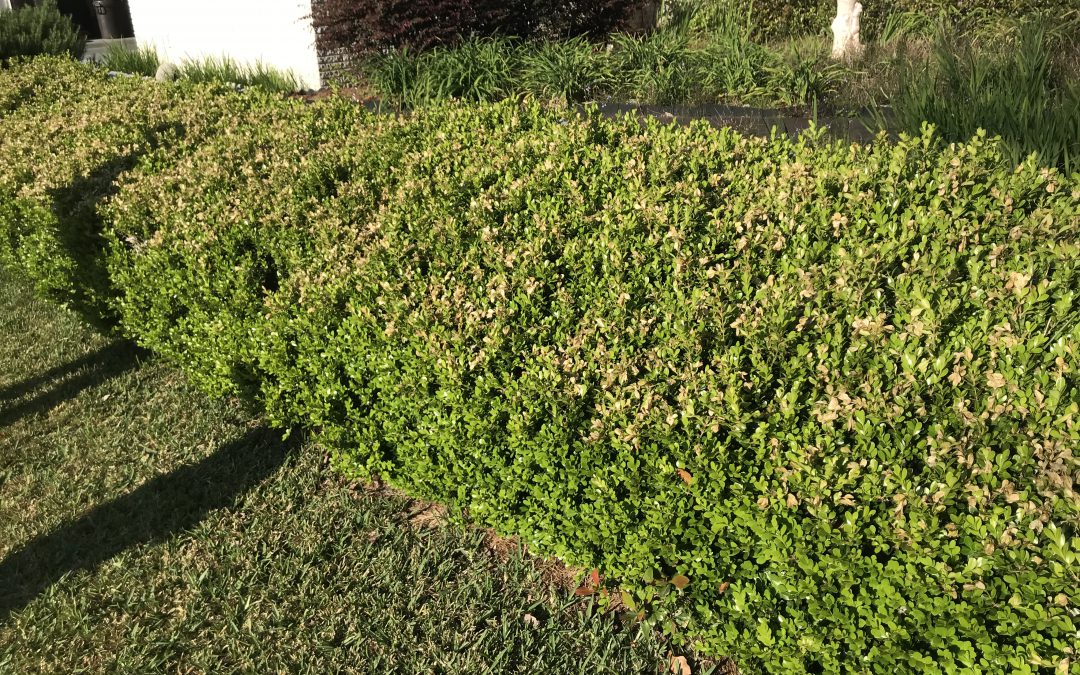
by Daniel J. Leonard | May 20, 2019
Spring is a wonderful time of year. After months of dreariness and bare branches, bright, succulent green leaves and flowers of every kind and color have emerged. So too, have emerged gardeners and outdoor enthusiasts ready to tackle all their home and landscape improvement projects planned over the winter. However, this is also the time, when folks first start paying attention to their plants again, that strange, seemingly inexpiable plant problems crop up!
All plant problems can be divided into two categories: biotic problems, or issues caused by a living organism (think insects, fungus, and bacteria), and abiotic problems, issues that arise from things other than biotic pests. It’s the first category that people generally turn to when something goes wrong in their landscape or garden. It’s convenient to blame problems on pests and it’s very satisfying to go to the local home improvement store, buy a bottle of something and spray the problem into submission. But, in many of my consultations with clientele each spring, I find myself having to step back, consider holistically the circumstances causing the issue to arise, scout for pests and diseases, and if I find no evidence of either, encouraging the person to consider the possibility the problem is abiotic and to adopt patience and allow the problem to correct itself. Of course, this is never what anyone wants to hear. We always want a solvable problem with a simple cause and solution. But life isn’t always that easy and sometimes we must accept that we (nor a pest/disease) did anything wrong to cause the issue and, in some cases, that we ourselves actually caused the problem to happen in the first place! To illustrate, let’s consider two case studies from site visits I’ve had this spring.
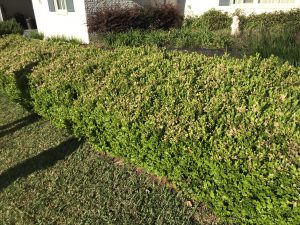
Cold damage on Boxwood hedge
Three weeks ago, I got a call from a very concerned client. She had gotten her March issue of a popular outdoor magazine in the mail, in which was a feature on an emerging pathogen, Boxwood Blight, a nasty fungus decimating Boxwood populations in states north of us. She had also noticed the Boxwoods in front of her house had recently developed browning of their new spring shoots across most the hedgerow. Having read the article and matching the symptoms she’d noticed to the ones described in the magazine article, she was convinced her shrub was infected with blight and wanted to know if there was a cure. Agreeing that the symptoms sounded similar and wanting to rule out an infection of an extremely serious pathogen, I decided to go take a look. Upon inspection, it was obvious that Boxwood Blight wasn’t to blame. Damage from disease generally isn’t quite as uniform as what I saw. The new growth on top of the hedge was indeed brown but only where the eaves of the house and a nearby tree didn’t provide overhead cover and, to boot, the sides of the hedge were a very normal bright green. Having gone through a recent cold snap that brought several mornings of heavy frost and knowing that the weeks before that the weather had been unseasonably warm, causing many plants to begin growing prematurely, all signs pointed toward an abiotic problem, cold/frost damage that would clear up as soon as the plant put on another flush of growth. The client was delighted to hear she didn’t have a hedge killing problem that would require either adopting a monthly fungicide regime or replacing the hedge with a different species.
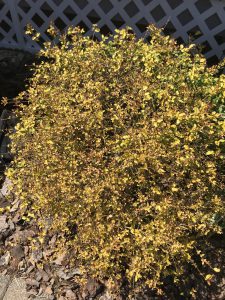
Damage to ‘Sunshine’ Ligustrum from pressure washing siding with bleach.
The very next week, another client asked if I would come by her house and take a look at a hedge of ‘Sunshine’ Ligustrum that lines her driveway, whose leaves had “bleached” out, turning from their normal chartreuse to a bronzy white color. This time, having seen similar issues with this particular plant that almost always involved an infestation of Spider or Broad Mites, I figured this was a cut and dry case that would end with a call to her pest control company to come spray the offending bugs. However, though the leaf damage looked similar, I was not able to locate any existing pests or find evidence any had been around recently, rather it appeared the leaves had been exposed to something that “bleached” and burned them. Puzzled, I began asking questions. What kind of maintenance occurs on the plants? Have you fertilized or applied any chemicals recently? Nothing. Then, near the end of our conversation, the client mentioned that her neighbor had pressure washed their house on a windy day and that she was irritated because some of the soap solution had gotten on her car. Bingo. Leaf burn from pressure washing solution chemicals. This time I was guilty of assuming the worst from a pest when the problem quite literally blew in on the wind from next door. Again, the client was relieved to know the plant would recover as soon as a new flush of growth emerged and hid the burned older leaves!
This spring, I’d encourage you to learn from the above situations and the next time you notice an issue on plants in your yard, before you reach for the pesticides, take a step back and think about what the damage looks like, thoroughly inspect the plants for possible insects or disease, and if you don’t find any, consider the possibility that the problem was abiotic in nature! And remember, if you need any assistance with identification of a landscape problem and want research-based recommendations on how to manage the problem, contact your local UF/IFAS Extension office.
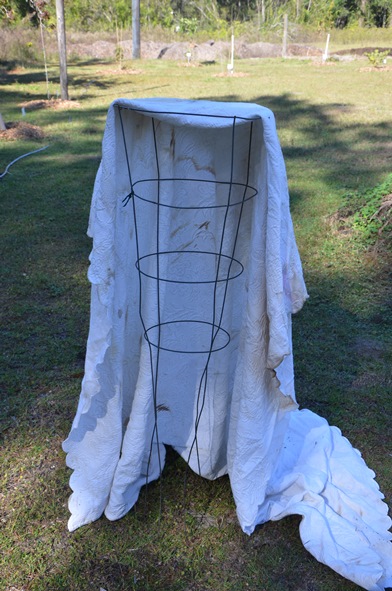
by Les Harrison | Jan 4, 2018
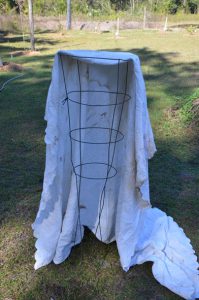
Photo Caption: Unused tomato cages are a perfect support for heavy covers which can protect delicate landscape shrubs during the frosts of winter. When spring arrives, they can again be used to support tomato plants. Image Credit Les Harrison
The Thanksgiving turkey is but a distant memory, the stores are stocking for the spring, and Christmas decorations are coming down.
The advent of the new year, finally brings the inevitability of cold and frosty weather. While nothing complements a nice eggnog or hot chocolate like a chill in the air, some northwest Florida landscape plants do not appreciate the dropping temperatures.
Gardeners face a new set of challenges dealing with the effects of cold weather. However, a little planning and creativity can make plant protection in the landscape a relatively simple process.
Many homeowners and landscape managers want to know when plants will need protection. Depending on the plant, the point of freezing is a good rule of thumb. Freezes will likely occur this season so preparations should begin now.
It is worth noting there is a difference in the terms used for cold weather conditions. Frost, freeze and hard freeze all describe different circumstances.
Frost is when water vapour freezes on surfaces. It usually happens on clear nights with still air and can happen when reported air temperatures are above freezing.
Freezing is when cold air moves in and causes temperatures to drop below 32 degrees Fahrenheit. This condition commonly involves low humidity and wind, making drying out a big problem for plants.
A hard freeze is when temperatures dip below 28 degrees Fahrenheit. Some tropical plants will survive a few degrees below freezing for very short periods, but extended periods of freezing or heavy frost may require lights or other heat used safely in combination with covering the plant.
In the Panhandle, most of the risk for sustaining freeze damage happens during the busy holiday season. People are busy, schedules are disrupted and the distractions, pleasant thought they be, may cause homeowners to miss a critical freeze alert in the media.
Some plants can be moved indoors for the cold months and incorporated into the interior décor, rather than cramming them last-minute into a chaotic bundle when a freeze looms.
While putting away the holiday decorations into storage, identify old sheets, blankets and drop cloths which can be used as covers for tender plants which must remain outside. Test potential covers beforehand to assure all plants will be thoroughly covered.
It is best if the covers enclose the plant entirely without crushing it. Heavy blankets are great insulation, but only a good idea on the sturdiest of plants.
A tomato cage or other support structure can be used to keep the weight off the plant. Covers also need to be secured at the ground with pins or weights to assure cold air does not enter from below and collect under the cover.
Finally, keep storage bins handy and remove the covers in the daytime if temperatures are above 55 degrees Fahrenheit.
Monitor weather reports and react accordingly so your tender and tropical plants see spring 2018. Santa will approve.
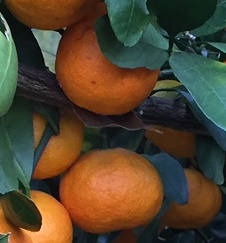
by Matthew Orwat | Dec 7, 2016
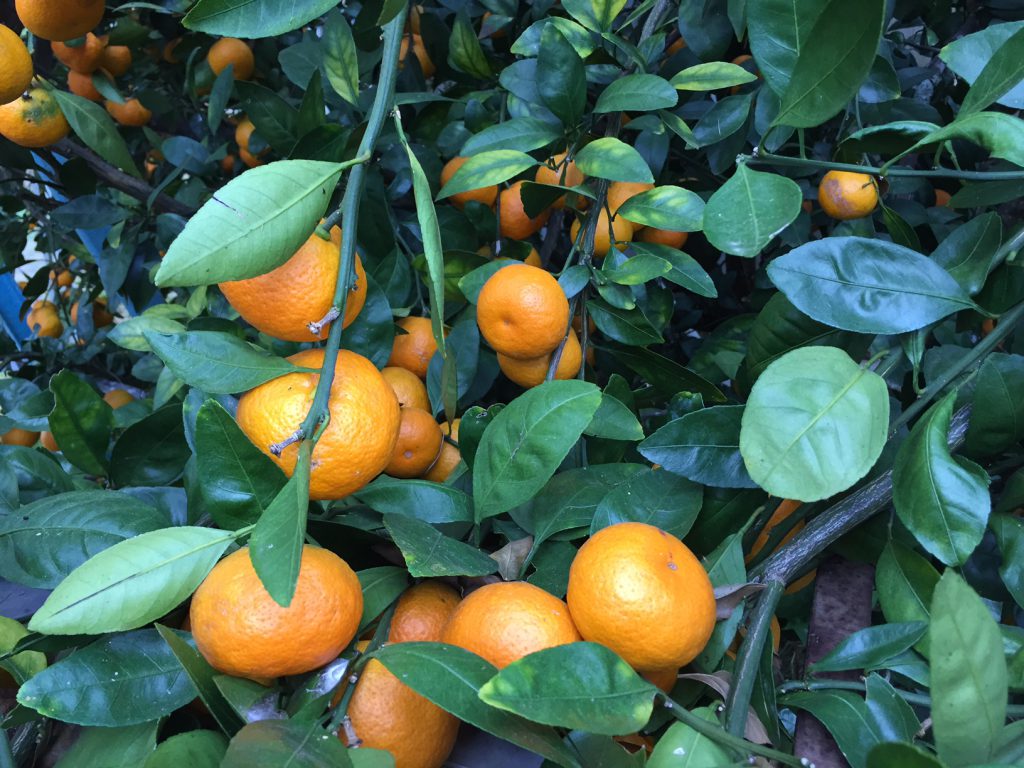
Fall 2016 Satsumas. Image Credit: Matthew Orwat
One question that repeatedly pops up in my Extension work is “When do I harvest fruit or vegetable X ?” This fall, the question of “when should I harvest my citrus?” has been a choice topic! The most common citrus in the Florida panhandle is the satsuma, Citrus unshiu, so it makes sense to limit this article to that species.
Harvesting satsumas can be a confusing activity for new citrus enthusiasts. Fall seasons in the panhandle tend to be extremely variable, from cold and wet to warm and dry or any combination thereof. To complicate matters, citrus is often grown in a protected microclimate in the garden. Thus, another variable is added to the decision tree.
Some harvest considerations to take note of:
- Sometimes the fruit is ready to harvest even when some green remains on the fruit
- Not all fruit on a given tree will be ready at the same time
- It’s a good idea to harvest a few fruit per tree and taste test….this will be a good indicator of the readiness of the other fruit on the tree
- A general trend to consider is that the longer the fruit remains on the tree, the sweeter it will become

Image Credit Matthew Orwat
When satsuma ripen, they become slightly soft. That’s a good indicator that they are ready to harvest. This softness makes them extremely easy to peel but poses a challenge when harvesting. If they are simply pulled off of the tree, some peel will be left on the tree and the fruit will be compromised. Such a fruit would have to be consumed quickly. To solve this problem satsuma are clipped off the tree, leaving a tiny bit of stem attached to the fruit. This allows the fruit to be stored and transported.
When a hard freeze is approaching (5 hours below 28ºF), it is important to harvest the fruit before this event whether or not they are ripe. Hard freezes will ruin the texture of the fruit and cause them to begin the rotting process.
Since a hard freeze is forecast for Friday December 9th 2016 for part of the Florida Panhandle, consult your local weather forecast and make your decisions accordingly. For an in-depth discussion on citrus fruit harvesting and cold tolerances, please consult this publication from Texas A& M University. Additional articles are available on cold protection and frost readiness here.

by Sheila Dunning | Jan 20, 2016
 While palms may survive, or even thrive, for years in climates cooler than those to which they are native, eventually they will experience temperatures cold enough to cause injury. Here in Northwest Florida, it was January 2014. Unfortunately, much of the damage was not evident until the summer of 2015. The palms held on with stored food reserves.
While palms may survive, or even thrive, for years in climates cooler than those to which they are native, eventually they will experience temperatures cold enough to cause injury. Here in Northwest Florida, it was January 2014. Unfortunately, much of the damage was not evident until the summer of 2015. The palms held on with stored food reserves.
When cold damage is severe, plant tissues are destroyed and water uptake into the plant may be reduced for years. Many times it is only the protected bud that will remain alive. The stem slowly weakens until it can’t support the weight of the crown and it collapses.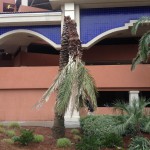
Winter is upon us again. So, if you still have palms in the landscape, be prepared, should we experience some extreme weather. Here’s a reminder of what to do.
One of the most common problems associated with freezes is that the freeze-killed lower portion of the spear leaf is degraded by secondary fungi and bacteria that are always present in our natural environment. Palm owners are often anxious to trim off the damaged leaves following a cold weather event. Avoid the temptation to remove these fronds until danger of additional freezes has passed. Even dead leaves provide insulation to the critical bud.
As the weather warms, the dead fronds need to be removed from around the bud so that the spear can begin to dry out. Drenching the bud area with a copper fungicide will reduce the secondary microbes. Repeat applications will need to continue as the palm leaves develop. Copper fungicides, unlike other fungicides, are active against bacteria and fungi. Be cautious to not use a copper nutrient spray rather than a fungicide. Delay fertilizer application until new fronds have developed. The best analysis for palms is 8-2-12 + 4Mg. Utilization of proper palm fertilization can improve cold hardiness of palms.
Palms damaged by cold can still show symptoms six months to a year following a freeze. New leaves in the spring may appear mis-shaped. Usually the palm will outgrow the damage. However, sometimes the palm loses its ability to take up water. If there is a sudden collapse of the fronds in the crown during the first hot days, the palm may die. There is nothing that can be done to save the palm.
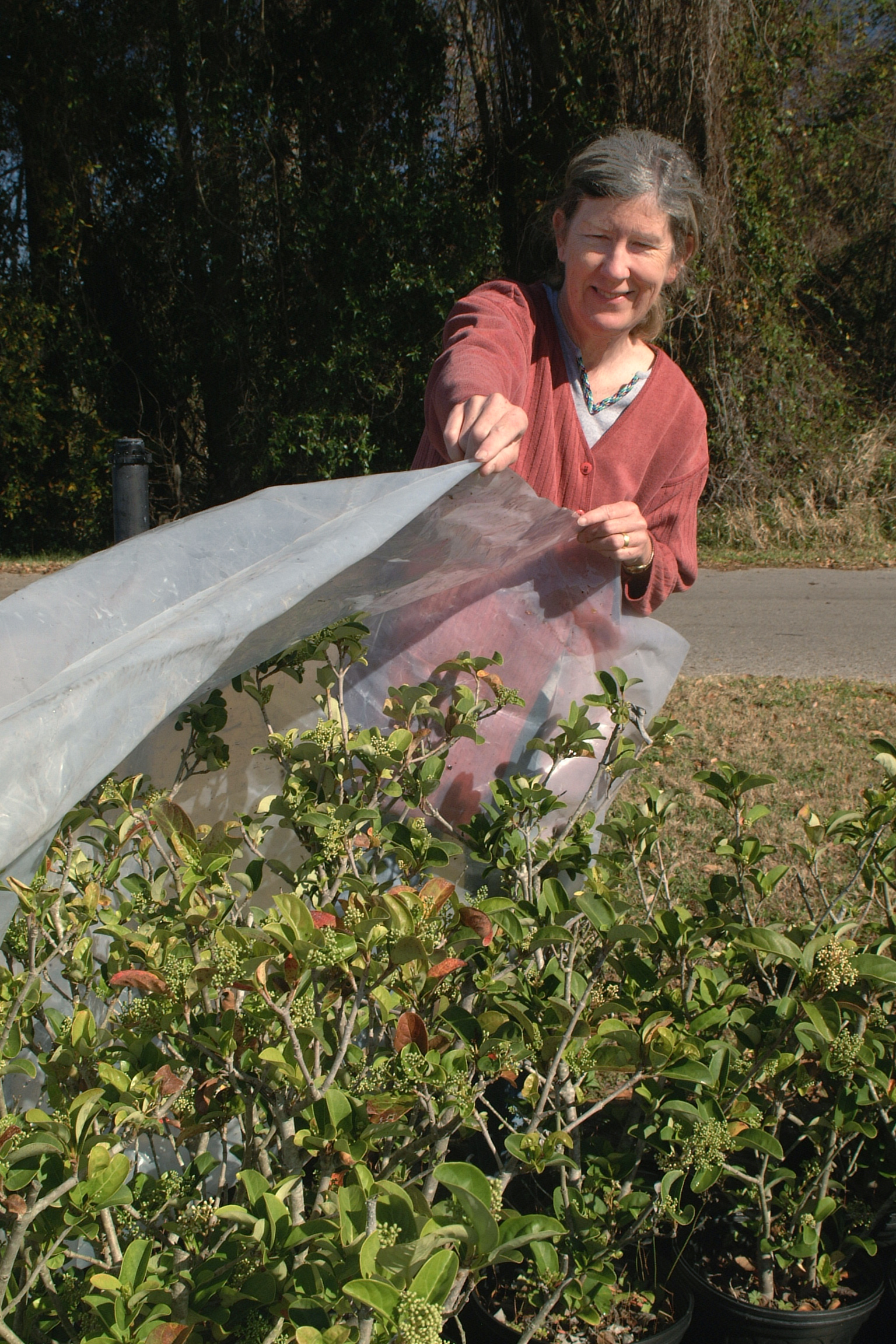
by Les Harrison | Jan 20, 2016
North Florida’s gardeners are facing a new set of challenges dealing with the effects of cold weather. However, a little planning and creativity can make plant protection in the landscape a relatively simple process.
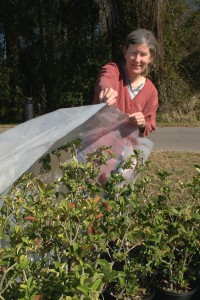
Covering plants to protect from frost. UF/IFAS Photo: Sally Lanigan.
Many homeowners and landscape managers want to know when plants will need protection. The point of freezing is a good rule of thumb for most temperate zone plants.
It is worth noting there is a difference in the terms used for cold weather conditions. Frost, freeze and hard freeze all describe different circumstances.
- Frost is when water vapour freezes on surfaces. It usually happens on clear nights with still air and can happen when reported air temperatures are above freezing.
- Freezing is when cold air moves in and causes temperatures to drop below 32 degrees Fahrenheit. This condition commonly involves low humidity and wind, making drying out a big problem for plants.
- A hard freeze is when temperatures dip below 28 degrees Fahrenheit. Some tropical plants will survive a few degrees below freezing for very short periods, but extended periods of freezing or heavy frost may require lights or other heat used safely in combination with covering the plant.
Some plants can be moved indoors for the holidays and incorporated into the interior décor, rather than cramming them last-minute into a chaotic bundle when a freeze looms.
Get prepared by identifying old sheets, blankets and drop cloths which can be used as covers for tender or tropical zone plants which must remain outside. Test potential covers beforehand to assure all plants will be thoroughly covered.
It is best if the covers enclose the plant entirely without crushing it. Heavy blankets are great insulation, but only a good idea on the sturdiest of plants.
A tomato cage or other support structure can be used to keep the weight off the plant. Covers also need to be secured at the ground with pins or weights to assure cold air does not enter from below and collect under the cover.
Finally, keep storage bins handy and remove the covers in the daytime if temperatures are above 55 degrees Fahrenheit.
Monitor weather reports and react accordingly so tender and tropical plants see spring 2016.












